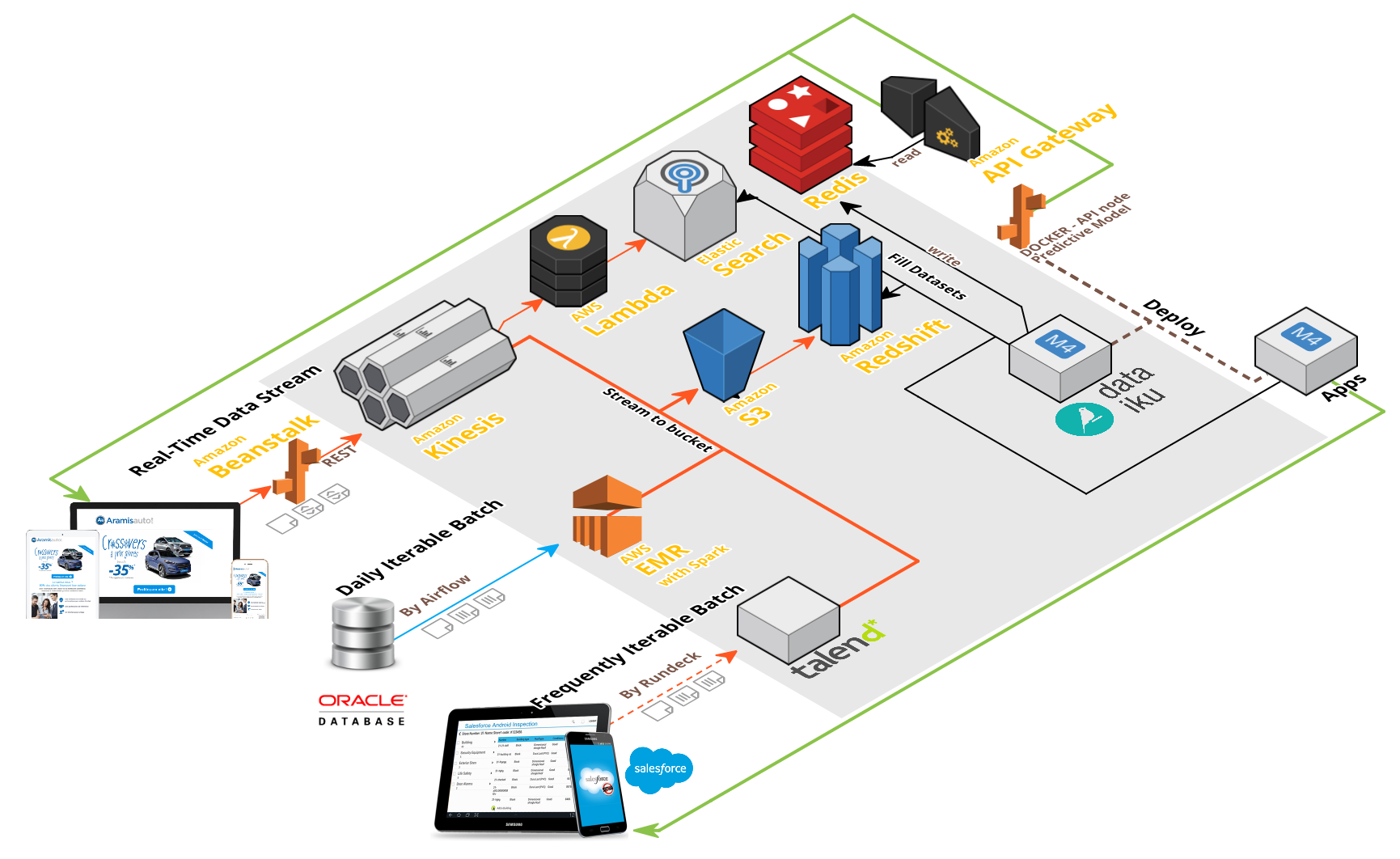Methods, Tools, and Use Cases of Deploying Machine Learning Models to Production
Nawfal Tachfine
Data Scientist
Company
- hybrid business model
- we buy and sell cars online
- 28 dealerships nationwide
- a car sold every 5 minutes
- 400+ employees
About
Data Team
- 1 chief data officer
- 1 manager
- 3 data engineers
- 6 data scientists
- 1 architect
Data Science @AramisAuto
- Mission - leveraging data to create business value
-
Approach
- measurement based
- business driven
- iterative (business problem → production < 3 months)
- Perspectives
-
Products
- Which cars to buy?
- At which price to sell?
-
Customers
- Which leads to call?
- How to distribute acquisition resources?
-
Products
Infrastructure

METHODOLOGY
Typical Data Science Workflow
formulate
problem
get data
build and clean dataset
study dataset
train model
+ feature selection
+ algorithm selection
+ hyperparameter optimization
Then what?

Enter Industrialization...
Goal
automatically serve predictions to any given information system
Constraints
-
Data - source refresh rate, enrichment
-
Model - stability, maintainability
-
Operations - scalability, resilience, availability
-
Resources - no dedicated developers
Philosophy
start from final use case and work your way back to data preparation
Conception
-
On demand - client/server architecture
-
Complete features → REST API
-
Partial features → enrichment necessary
-
Lookup sufficient → REST API + key-value data store
-
Complex enrichment from database → API usable but slow
-
-
-
Trigger-based (time/event) → batch mode
-
Computationally efficient
-
Can serve predictions directly to destination
-
When will predictions be computed?
Design Patterns
-
Think about your production use-case as early as possible.
- Your data pre-processing pipelines must be deterministic and reproduce the same conditions as in training.
- make your transformations robust against abnormal values
- variable order matters (cf. scikit-learn)
- Log as much as you can.
- Make sure your development and production environments are identical (esp. framework versions!)
- Write clean code: your models will evolve (re-training, new features, ... etc)
- Keep things simple - stability trumps complexity.
TOOLS
Dataiku
-
DSS Scenarios
- customizable (cf. global variables)
- simple to integrate
- API, triggers, and reporters → easy scheduling and monitoring
-
API Scoring Node
- easy to deploy and update models
- lightweight
- compatible with DSS visual models
-
Automation Node
- data-change triggers
- built-in orchestration
- advanced monitoring
Toolbox
Flask - a python web application microframework
- simple,
- lightweight,
- powerful

Serialization - persisting models on disk
- pickle / joblib dump
- POJO objects for JVM-based environments
- PMML
@app.route('/api/v1.0/aballone', methods=['POST'])
def index():
query = request.get_json()['inputs']
data = prepare(query)
output = model.predict(data)
return jsonify({'outputs': output})
if __name__ == '__main__':
app.run(host='0.0.0.0')- JSON - universal I/O format
-
Docker - soft virtualization:
- no more dependency problems
- runs (almost) anywhere
-
AWS EC2 - flexible cloud computing resources
- spot instances for cost optimization
-
AWS Elastic Beanstalk - web app deployment and scaling
- (very) easy to use
- (relatively) cheap
- provides auto-scaling and load-balancing
- Redis - powerful in-memory key-value data store
- Elasticsearch - NoSQL text search engine for JSON documents



Toolbox (cont.)


USE CASES
Use case 1 - Pricing
- Goal - providing price estimates for clients' used cars online
- Use - web service callable by website
- Features - 14 car descriptors (brand, model, age, energy, trim, mileage, transmission, engine)
- Model/Performance - XGBoost regression, test MAPE <5%
- Deployment Specs - response <100ms, JSON I/O
- Solution - dockerized API Scoring Node on AWS Elastic Beanstalk, manual model deployment

Dataiku
API Node
query
prediction


Use case 2 - Inventory Turnover
- Goal - predicting how long a car would take to be sold
- Use - web service callable by internal quote generation tool
- Features - car characteristics, competition descriptors (25 total)
- Model/Performance - XGBoost classification, test accuracy 76%
- Deployment Specs - response <5s, JSON I/O
- Solution - dockerized Flask enrichment API via AWS Redshift, dockerized API Scoring Node on AWS Elastic Beanstalk
API Node
query
predictions
Backoffice
Redshift
Master API
partial features
full features
features
predictions







Use case 3 - Lead Scoring
- Goal - detecting leads most likely to transform into customers
- Use - sorting lead portfolios for sales representatives in Salesforce
- Features - 11 offline (localization, email, phone calls, ...) + 47 online (visits, searches, viewed pages, quotes, vehicle preferences, ...)
- Model/Performance - scikit-learn RandomForest classification (unbalanced), 75% of test set targets in top 10% scores
- Deployment Specs - history-based enrichment, fresh data every 15min
- Solution - Flask app, batch mode, loop run, dataprep in Redshift, result sync to Salesforce, Rundeck deployment on EC2


Redshift

Scoring App
leads
features
scores
Use case 4 - Visitor Scoring
- Goal - detecting visitors most likely to transform into leads
- Use - selecting visitors to target in SEM/Retargeting campaigns
- Features - online behavior descriptors + acquisition channels interactions
- Model/Performance - scikit-learn RandomForest classification (unbalanced), 79% of test set targets in top 3% scores
- Deployment Specs - history-based enrichment, fresh data every 15min
- Solution - [TEST] DSS daily Scenario, Redshift dataprep, sync to Redis

Redshift



DSS Scenario
lookup
score
features
scores
Infrastructure (again)


@NawfalTachfine




